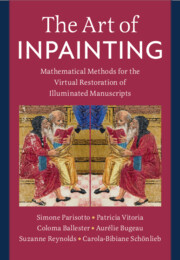Refine search
Actions for selected content:
118 results
17 - English Rap in India and the Fault Lines of Sociolinguistic Politics
- from Part IV - Contexts for Rap
-
-
- Book:
- The Cambridge Companion to Global Rap
- Published online:
- 25 July 2025
- Print publication:
- 14 August 2025, pp 249-260
-
- Chapter
- Export citation
Chapter 2.5 - Local Anaesthetics
- from Sec 2 - Pharmacology
-
- Book:
- Dr Podcast Scripts for the Primary FRCA
- Published online:
- 19 June 2025
- Print publication:
- 03 July 2025, pp 226-233
-
- Chapter
- Export citation
Data for peace: how novel data sources and technology can enhance peace?
- Part of
-
- Journal:
- Data & Policy / Volume 7 / 2025
- Published online by Cambridge University Press:
- 27 June 2025, e45
-
- Article
-
- You have access
- Open access
- HTML
- Export citation

The Art of Inpainting
- Mathematical Methods for the Virtual Restoration of Illuminated Manuscripts
-
- Published online:
- 22 May 2025
- Print publication:
- 22 May 2025
Subnational policy entrepreneurs in action: a systematic quantitative review
-
- Journal:
- Journal of Public Policy / Volume 45 / Issue 2 / June 2025
- Published online by Cambridge University Press:
- 14 April 2025, pp. 372-398
-
- Article
-
- You have access
- Open access
- HTML
- Export citation
Towards an Asia-Pacific ‘Depopulation Dividend’ in the 21st Century Regional Growth and Shrinkage in Japan and New Zealand
-
- Journal:
- Asia-Pacific Journal / Volume 15 / Issue 6 / March 2017
- Published online by Cambridge University Press:
- 14 March 2025, e5
-
- Article
-
- You have access
- Open access
- Export citation
Chapter 6 - Translocal Lyric
-
- Book:
- The Environmental Poetry of Augustan Rome
- Published online:
- 12 December 2024
- Print publication:
- 19 December 2024, pp 228-257
-
- Chapter
- Export citation
Chapter 4 - Poetry of Place and Planet
-
- Book:
- The Environmental Poetry of Augustan Rome
- Published online:
- 12 December 2024
- Print publication:
- 19 December 2024, pp 146-179
-
- Chapter
- Export citation
Introduction
-
- Book:
- The Environmental Poetry of Augustan Rome
- Published online:
- 12 December 2024
- Print publication:
- 19 December 2024, pp 1-19
-
- Chapter
- Export citation
Chapter 1 - Local Dwelling and Pastoral Place in Vergil’s Eclogues
-
- Book:
- The Environmental Poetry of Augustan Rome
- Published online:
- 12 December 2024
- Print publication:
- 19 December 2024, pp 20-59
-
- Chapter
- Export citation
16 - Clare among the Poets
- from Part IV - Influences and Traditions
-
-
- Book:
- The Cambridge Companion to John Clare
- Published online:
- 14 November 2024
- Print publication:
- 21 November 2024, pp 241-256
-
- Chapter
- Export citation
8 - Clare and Ecocriticism
- from Part II - Clare the Naturalist
-
-
- Book:
- The Cambridge Companion to John Clare
- Published online:
- 14 November 2024
- Print publication:
- 21 November 2024, pp 120-134
-
- Chapter
- Export citation
Ethnic diversity and political trust at the onset of the COVID-19 pandemic
-
- Journal:
- European Political Science Review / Volume 17 / Issue 1 / February 2025
- Published online by Cambridge University Press:
- 07 November 2024, pp. 99-109
-
- Article
-
- You have access
- Open access
- HTML
- Export citation
Sustaining gender: Natural resource management, conflict prevention, and the UN Sustaining Peace agenda in times of climate catastrophe
-
- Journal:
- Review of International Studies / Volume 50 / Issue 5 / September 2024
- Published online by Cambridge University Press:
- 19 February 2024, pp. 821-835
- Print publication:
- September 2024
-
- Article
-
- You have access
- Open access
- HTML
- Export citation
Introduction
-
-
- Book:
- Young Children and the Environment
- Published online:
- 05 January 2024
- Print publication:
- 05 January 2024, pp 1-4
-
- Chapter
- Export citation
Consumer preferences for produce grown with reduced pesticides: a choice experiment in Missouri
-
- Journal:
- Renewable Agriculture and Food Systems / Volume 38 / 2023
- Published online by Cambridge University Press:
- 01 December 2023, e49
-
- Article
-
- You have access
- Open access
- HTML
- Export citation
7 - Machine Learning for Big Data
- from Part III - Machine Learning for Big Data
-
- Book:
- Large-Scale Data Analytics with Python and Spark
- Published online:
- 15 December 2023
- Print publication:
- 23 November 2023, pp 212-253
-
- Chapter
- Export citation
Teaching Latin and ancient Greek in the 21st-century Primary School: Framing local approaches to international challenges
-
- Journal:
- Journal of Classics Teaching / Volume 25 / Issue 49 / Spring 2024
- Published online by Cambridge University Press:
- 29 August 2023, pp. 33-38
-
- Article
-
- You have access
- Open access
- HTML
- Export citation
4 - England in the Fourteenth Century
-
-
- Book:
- The Cambridge Constitutional History of the United Kingdom
- Published online:
- 12 August 2023
- Print publication:
- 17 August 2023, pp 84-107
-
- Chapter
- Export citation
17 - Working across Scales and Actors for Transforming Food Systems
-
-
- Book:
- Transforming Food Systems Under Climate Change through Innovation
- Published online:
- 19 January 2023
- Print publication:
- 19 January 2023, pp 197-208
-
- Chapter
-
- You have access
- Open access
- HTML
- Export citation
